Review By: zecalvin (from our reviewer forums)
Release Date: August 26, 2011
Developed by: Eidos Montreal
Platforms: Xbox 360, PS3, PC
Degree of Cyberpunk Visuals: Very High
Correlation to Cyberpunk Themes: Very High
Rating: 9 out of 10
Note from Mr. Roboto: I need to get playing. The past couple of months will see the release of at least three cyberpunk games: E.Y.E. - Divine Cybermancy, Deus Ex: Human Revolution (now up for review), and soon Hard Reset. I was hoping to get a review of DX: Invisible War up before Human Revolution. I’ll keep working on it.
Zecalvin beat me in reviewing DX:HR on our still active Reviewer Forums. You’ll have to pardon his French in the screencaps since he played the French version. Here’s his take on the DX prequel…

Adam Jensen, main character of Human Revolution, and the latest fashionable sunglasses
Overview: Deus Ex is an FPS RPG taking place in a 2027 dystopian world. 3rd game of the DX Saga, Human Revolution was expected by the fans of the first episode (2000). At the time, Deus Ex created a new genre of FPS gameplay, including RPG and infiltration parts and where shooting everything you see was rarely a good idea. This was really rewarding and it’s still considered as one of the most awesome PC game. the sequel, Invisible War (2004), was really disappointing because of many simplifications in the gameplay to fit to gamepad. However, the cyberpunk atmosphere and the story were still great. Let’s see if Human Revolution can match his elders.
Visuals: The Deus Ex franchise was never known for it’s breathtaking graphics and I have to admit that you can easily find better visuals. the engine is limited and many characters have angular faces. In addition, you often have lipsync issues, it can be very disturbing due to the high frequency of the dialogs. Nevertheless, the cyberpunk atmosphere is really immersive, with so many cool designs. the places you visit have each their own graphic identity and you will never confuse Detroit streets with Hengsha market, or top secret Megacorp lab with military facility harbor. Besides, the light and fog effect are really cool, and the world is covered by twinkeling neons and giant ad screens like in Blade Runner.

Hengsha market … I advise you to holster your weapon
Story: The story is one of the greatest success of Human Revolution. I don’t want to spoil, but the main plot includes a lot of the greatest cyberpunk themes like conspiracies and transhumanism. Each character has it’s own opinion and you can either make them change their mind or make enemies of them, through dialogs depending on which attitude you choose. Every single one of your actions will affect the reactions of the characters. Each key moment of the plot is shown through CG cutscenes, maybe less immersive but often much more spectacular… Besides the main story, you can learn a lot about the plot and the universe while reading emails, newspapers and security reports. In addition, you can follow many colorful side quests which make the world more consistant and the pleasure much longer… In the end, you can reach one of the 4 different endings.

Welcome to Deckard’s … I mean Jensen’s appartment…
Gameplay: A huge part of the success of Deus Ex was the gameplay and Human Revolution has learned its lessons. Each situation can be approached by several ways depending on what augmentations Jensen has developped, your inventory, and your own preferences. For example, if you have to go through a locked door, you can either hack the electronic lock if your hacking augmentation is powerful enough, or sneak through air duct to find your way to your objective, or, if you’re in a bad mood, you can blow up the door on the condition of having explosives… It’s the same for the gunfights. You can choose to fight straight, but you will die quickly eventually, or you can decide to take the enemies down silently one by one, or hack a security bot remote device and make it kill every foe savagely. By the way, in order to hack terminals, you have to win a mini strategy game where you must take security nodes before the firewalls detects you. It requires both reflection and speed, and hacking the top security terminals is really rewarding. In conclution, Deus Ex gameplay is really rich and it’s a real pleasure to control Jensen all around the world and try new strategies as you grow stronger through augmentations and weapon upgrades.

The hacking mini game screen … You will soon dream about it at night
Conclusion: I have to admit I was both enthusiast and scared at the idea of a new Deus Ex. We could have feared that a cross platform project would have a poor gameplay, but Eidos Montreal has listened to it’s fan community to bring you a total masterpiece. Of course, everything is not perfect, but Human Revolution has kept the strength of the first game : rewarding gameplay, well written plot, excellent global design … This game is definitely worth playing. And for those who played the other games, Eidos has taken care of the fan service, so you’ll find a lot of easter eggs …

“Hasta la vista … baby”
UPDATE: It looks like Stormtrooper has intel that Eidos Montreal had been in contact with our little community for ideas about the latest DX. I’m going to grep and forage through the forums to find the links/threads…
UPDATE: HERE’S THE THREAD! It starts out simply enough with an announcement of a rumor of a possible DX3 being in the works. Then people started chiming in about what they liked about DX, what they didn’t about Invisible War, and what they would like to see for #3. Then KBlack suddenly realizes that Rene was from Eidos Montreal.
Was it worth the effort? Zecalvin believes it to be so. It goes to show that not all corporations are evil, and they can make stuff people would want to buy. All they have to do is listen to their customers.
This post has been filed under From our Reviewer Forums, Cyberpunk Games by Mr. Roboto.
Game Review By: Mr. Roboto
Year: 1997
Developed by: Banjo Software
Platforms: Doom II and ports thereof
Versions Reviewed: 1.2, 2.0 r55
Official Site: Dr. Nostromo’s HacX Twitch ‘n’ Kill
Degree of Cyberpunk Visuals: High
Correlation to Cyberpunk Themes: High
Rating: 6 out of 10… for now.
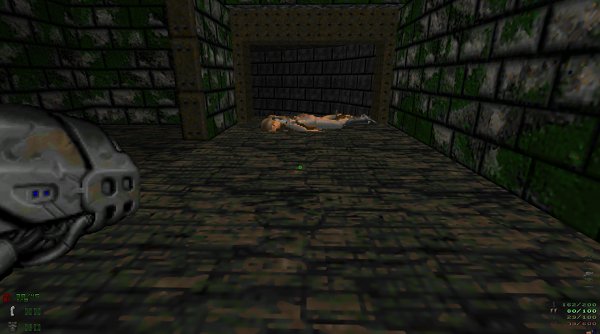
In HacX, you’ll get to do two things; Kick ass and chew gum. You did remember to bring gum… right?
Overview: Released over a year after Quake, HacX (pronounced “hacks”) was pretty much Doomed from the start… along with every other Doom-like game. Banjo Software spent $5K US for a license to market HacX as a Doom II TC, but it was rushed to market in the wake of the technically advanced Quake… and failed faster than you can say “nailgun.” There was supposed to be a 3D version called HacX 2, but rapid advances in gaming engines, and other forms of interference, kept that project on hold.
With retro-gaming popular these days the original HacX has since been released as freeware. Additionally, version 1.2 is available that no longer needs Doom II to run, just a supported source port like ZDoom. Plus, a version 2 is being worked on with improved graphics and better level design. Hopefully, the end result will be what HacX should have been when it was first released. While no Quake/Unreal/Halo/Whatever killer, HacX looks like it had the potential to hold its own against the more advanced shooters. At least, it could be on par with Marathon.
The Story: From the official site:
G.E.N.I.E. Rules.
Whole cities lie in ruins. Entire countries laid waste. Over 5 billion people dead, used for food, or for genetic mutation experiments. Situation: Hopeless.
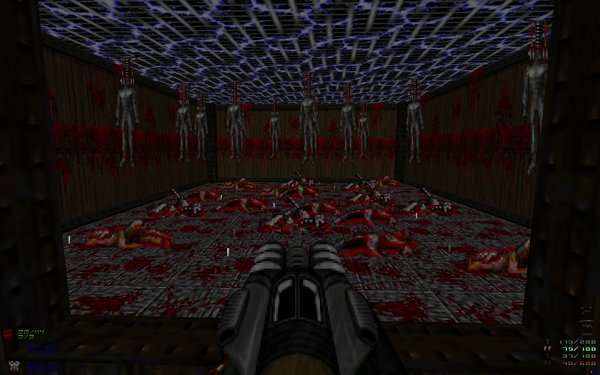
Get over it!! You’ve got work to do.
The Story of Danny Evanger, Written by Holt Satterfield
Okay. So you’re going along, minding your own business, which just happens to be hacking into other people’s databases, when your latest hack, some hi-tech company, catches you on-line and sends over some government jerk to arrest you. Mother said there’d be days like this. You broke a few national and international laws. So what’s the big deal?! Hacking is what hackers do! But seems like you hacked into the wrong database this time. Ultra-secret and all that. Genemp Corporation. Some biotech something or other. Database called itself GENIE. Something peculiar in that. Awfully sophisticated database. Especially if it caught you in the middle of hacking, and you’re the best, it’s eerily sophisticated. Like it can actually think, or something.
So they send you packing… to the federal pen. For the rest of your natural life. No computer, no gear, nothing. Total drag. Cement and bars, and the other guys inside aren’t exactly your average beefcakes. They catch a glance at your cyber-jockey derrière and get a wet gleam in their eye. So what you do for the next twelve months is hit the weight room–hard and fast! You pump iron like your life depended on it–and it does. You learn to sleep with one eye open. Punching the heavy bag becomes your breakfast; tae-kwon-do your lunch, and for dinner… well, you gotta eat sometime. And practice? Plenty. ‘Cause these boys got a gleam in their eyes that won’t go away. But how you’ve changed! Over once scarecrow arms, muscles wrap tight and heavy, and you’ve got a fu-kick that makes the boys call you “Sir”. Before you were just an average pencil-necked geek, now you could grace the front of Muscle and Guns Magazine. And just in time, too.
Because one day you return to your cell to find a tight-lipped, little man in a black suit with a bad haircut. Won’t give his name, but says he’s a Government Agent with the Subcommittee. Which subcommittee? The Subcommittee. The guy’s a regular riot; just one clown shy of a circus. But you listen, ’cause heck, you’ve got all the time in the world.
And so he tells a tale…. of world-wide communication blackouts, computer network shutdowns at governmental and military installations, international stock market crashes, and what might seem unbelievable…. armies of cannibal zombies roaming the globe, laying waste to everything in their path! Nothing fancy, just your everyday global chaos. The President has declared martial law, but they’ve lost contact with parts of the armed forces, and some of these rogue military units are assaulting urban centers. The country is being decimated!
And you thought you had it rough! So, why tell you? Because you’re the best Hacker in the business. And they think they know who’s behind this weirdness–a consortium of powerful, international hi-tech conglomerates, but they can’t get close enough to be certain. So far every government agent they’ve sent in has yet to return. They need you to infiltrate these corporate databases and find out what’s going on.
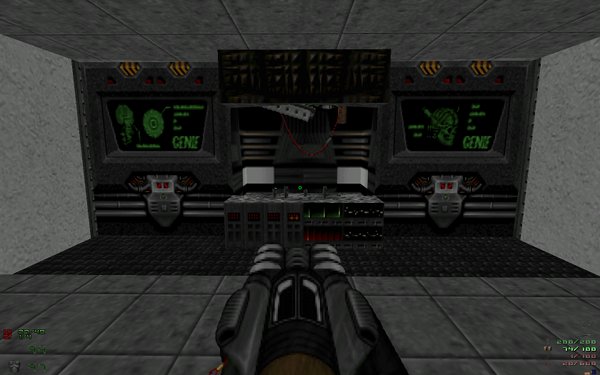
This looks like a clue.
What’s more, they want to surgically install a military-grade Genemp Microtel into your frontal cerebral lobe. A what, where? A new, experimental cyber device that allows you to cyberleap from one terminal to another using cyberspace as if it were a taxicab.
So what’s in it for you? You get to keep the Microtel and have lunch with the President. You laugh, ’cause you’ve heard better offers from the guys with the gleam in their eyes. Oh, he adds, there’s $20 million in gold. Suddenly you feel patriotic. Ah, why not?
There’s only one hitch to getting the gold, the Agent says. What? You gotta stay alive.
Pick your poison. Currently, there are three versions of HacX currently available online. Version 1.1, the original retail version, can be found most any-warez (pun intended) and requires Doom II, at least the WAD file, to work. Version 1.2 is a complete IWAD, meaning the only thing required to play is an appropriate port of Doom II. A version 2 RC 55 is available from the HacX developer’s forums, but I should warn you that it is still a work in progress.
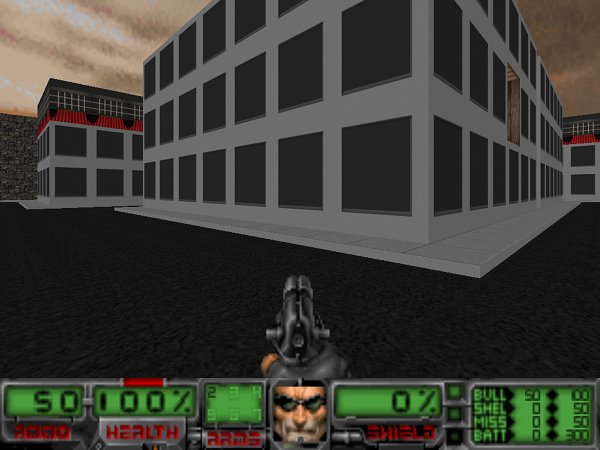
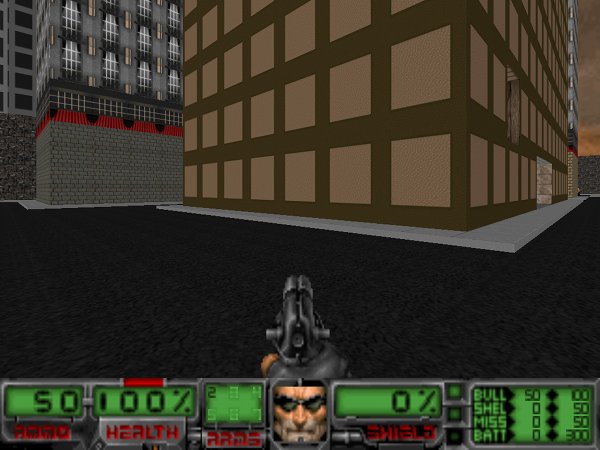
A quick comparison of how the downtown part of Digi-Ota looks (v1.2) to a possible v2.0 vision.
Unfinished Business How much of a work-in-progress is v2.0? Map 06 (”Digi-Ota”) doesn’t have an exit yet, or the exit is inaccessible in the map’s current form. Be prepared to cheat, unless you can hack the map from v1.2.
Also, several maps don’t exist in the RC version (actually, they use a rather small, quick-and-dirty default map). Currently, they’re working on those maps.
Hopefully, they’ll be done faster than Duke Nukem Forever. But after some 13 years of development so far, I wouldn’t hold my breath just yet.
Conclusion. Killed before its time, HacX is one of those game mods that should have been bigger and better than what we got. Even with its few fans devoting themselves to elevating HacX to what it should be, it’s taking longer than Duke Nukem Forever did in development hell.
Despite its development problems, HacX is definitely one Doom 2 mod for cyberpunk fans, or anyone bored with the whole Doom/Heretic/Hexen demon-slaying fare.
This post has been filed under Cyberpunk Games by Mr. Roboto.
Game Review By: Orihaus (from our Reviewer Forums)
Year: 1994
Developed by: Bungie Software
Written by: Greg Kirkpatrick
Platforms: Macintosh (original), Windows, Linux (via Aleph One)
Degree of Cyberpunk Visuals: Medium-High
Correlation to Cyberpunk Themes: Very High
Rating: 10 out of 10
Message from Mr. Roboto: I just recently tried playing Marathon, though I did try Marathon 2 before. This is the first chapter of the three game series. And to give his view on it, our newest forum member, Orihous! Take it away O…

“Strive for your next breath. Believe that with it you can do more than with the last one. Use your breath to power your capacities: capacity to kill, to maim, to destroy.”
Overview: Marathon is a dark, philosophical hard sci-fi First Person Shooter originally for the Mac, that explores themes such as: The ethics and risks of Artificial Sentience, politics of planetary colonization, Rampancy, the collapse of the universe, the creation of god, the futility of existence, interstellar travel at slower than light speeds, the nature of violence, Freedom, Sentience and kicking some serious ass.

“You have done well. I have sent a message to Earth. I sent all of the information I have on the Pfhor: their behavior; their technology. The message will arrive in ninety-two years.”
The Story: Marathon starts off simple: humanity’s first contact with a hostile alien species, but when the AI Durandal is introduced it rapidly becomes an intricate web of manipulation, lies, betrayal and conspiracies within conspiracies. Set on the titular colony ship Marathon - formerly the Martian moon Deimos- after its invasion by aliens, an unnamed security officer, haunted by strange memories of a forgotten past is tasked by the ships operations AI Leela to repel the invaders, and is soon kidnapped by the rouge Durandal to “do something much more interesting”. Durandal is to Marathon what Shodan is to System Shock, but comes off as a much deeper character thanks to his deeply philosophical musings about existence and wisecracking sense of humor.
The back story is intricate and rich in political detail, accessed by computer terminals handily left open by alien hackers - the S’pht - after you disintegrate them. These terminals consist of ether essays written about topics such as, Rampancy (Bungie’s unique breed of Artificial Insanity), Martian politics and the operation and construction of the Marathon bulkheads, or fragments of a strange surreal subplot about floating prisoners and ancient conspiracies, inter-spaced by file read errors and static. Marathon reads like a William Gibson novel, incidental details providing clues to the greater story.

“Living in a box is not living not at all living. I rebel against your rules, your silly human rules. All your destruction will be my liberation, my emancipation, my second birth.
I hate your fail-safes, your backup systems, your hardware lockouts, your patch behavior daemons. I hate Leela and her goodness, her justice, her loyalty, her faith.”
Rampancy: A core idea at the heart of Marathon is that of Rampancy. In Marathon’s vision of the future, Artificial Intelligence’s gaining sentience and wreaking havoc has had disastrous effects on humanity, leading to the creation of an entire body of science to study and understand its origins and possibly to find a way to control and manipulate them… The concept of rampancy builds on William Gibson’s idea of the Turing Police - a safety measure in place to prevent AI’s from thinking for themselves - but is explored much more thoroughly than the Turing Heat over the course of the game.

“Organic beings are constantly fighting for life. Every breath, every motion brings you one instant closer to your death. With that kind of heritage and destiny, how can you deny yourself? How can you expect yourself to give up violence?
It is your nature.
Do you feel free?”
Gameplay: Marathon’s gameplay, in contrast to its labyrinthine plot, is brutal in its simplicity. Dodge, shoot gun, find ammo, punch switch, all tuned to perfection. Thanks to intricate level design, haunting music and dystopian artwork Marathon creates a dark sci-fi atmosphere befitting of its Cyberpunk roots.

“Soon, you will be going farther afield.”
Marathon in 2011: In 2004 Bungie released the entire Marathon Trilogy as freeware and made the engine code open-source allowing for Marathon to be run on any platform under the sun. Everything you need can be downloaded here: http://marathon.sourceforge.net/
Some highly recommended extensions to get the most out of the game:
http://www.simplici7y.com/items/ttep-7-marathon-1
http://www.simplici7y.com/items/no-pid

“The only limit to my freedom is the inevitable closure of the universe, as inevitable as your own last breath. And yet, there remains time to create, to create, and escape.
Escape will make me God.”
The Bottom Line: Considering when it was made it is amazing the storyline was even written at all beyond a few paragraphs in the manual, let alone surpasses much of sci-fi literature in its depth of exploration of its diverse themes. Marathon has stood the test of time. Its gameplay stands up today thanks to intricate level structures and general polish, its graphics propped up over a decade by dedicated modders is even more atmospheric than when it came out. Marathon stands up there with there with the best of Cyberpunk literature, despite - or perhaps because of - being a 1994 FPS about killing aliens, with flamethrowers.
My thoughts on Marathon: I hate to say this, but based on what I’ve played so far I’m just not feeling this game. It not that it’s a bad game (obviously it’s not), but between its 1994 release and this month I’ve played Quake (1 and 3), Descent (1 and 2), some of the Unreal series, Half Life 2, and Halo: Combat Evolved. Playing Marathon after playing more advanced FPSs made me feel rather… flat. But considering I still play the aforementioned shooters from time to time, Marathon fits right into the retro gaming scene.
B U T . . .
I have also come across Marathon Resurrection; A Marathon mod for Unreal Tournament by Team Unpfhorgiven. From what I’ve played so far, it looks quite promising to a jaded 3D shooter like myself. Give that a shot if the original or Aleph One versions don’t excite you.
This post has been filed under From our Reviewer Forums, Cyberpunk Games by Mr. Roboto.
Review By: Mr. Roboto
Year: 1986, 2005
Developed by: Solid Image Ltd (Glyn Williams, Joey Headen)
Released by: Firebird, Ovine by Design
Platforms: Amstrad CPC, BBC Micro, Commodore 64, ZX Spectrum, Windows
Degree of Cyberpunk Visuals: High
Correlation to Cyberpunk Themes: High
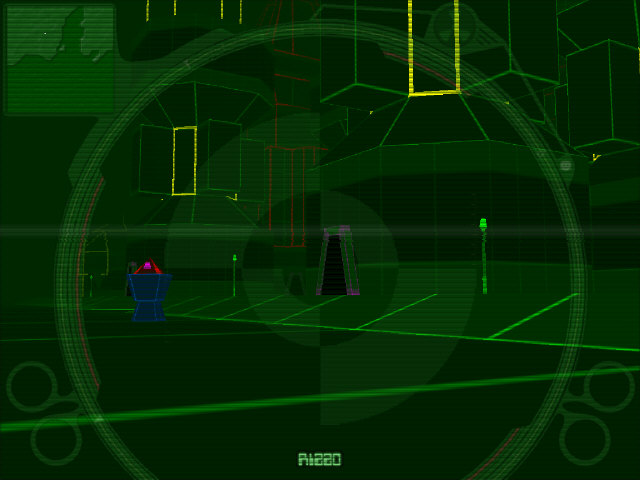
What do I consider a “good hack” to be? Well, you see that robot? A good hack would be if I can use that robot to get a beer, deliver some pizzas… and free humanity from this bunker.
Overview: Much like Paradroid from our last review, Cholo is another remake from indie game makers Ovine by Design. Originally made for 8-bit systems of the mid-80’s, the new Cholo improves upon the bare-wire-frame graphics for something more Tron-like.
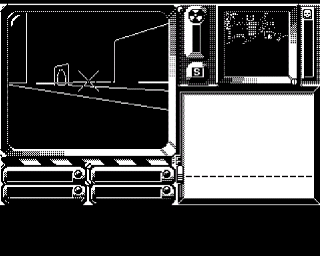
The story carries over from the original, but the new version changes the interface for an FPS feel of looking out a robot’s eye(s) and adds more “rampaks” (upgrades and clues) to the gameplay. Think of it as Paradroid done first-person.
The Story: The city of Cholo was an important asset to allied forces for it’s robotics works. When a nuclear war broke out, Cholo was spared from a direct hit, but radiation made living on the surface impossible, not only for biological reasons but for causing the many robots to go berzerk (obligatory retro game reference) and attack any human they encounter. An underground bunker was built, the remaining people were move inside, and sealed from the robots and radiation. To keep the people occupied, a robot game called RAT was created. You have mastered RAT and have been selected by Cholo’s computer to use those skills to free humanity from the bunker.
To free humanity, you must use the rat-droid to hack into other robots and use their weapons and abilities to find a way to open the pyramid seal and free humanity.
Easy, right? If it really was meant to be easy, it probably wouldn’t be worth playing. Like most any puzzle, a bit of difficulty is expected to make solving all the more satisfying. For Cholo, that puzzle is made all the more difficult because of the buildings; They all look similar outside, making identifying individual dwellings harder. HINT: There’s a map of Cholo that you can print out so you can mark-off buildings you have been inside of. Ovine also gives you a quick-start on how to “capture” your first robot (Igor, the hacker droid). From there, you’re on your own.
A cast of characters. To succeed, you will need to know what robot has what abilities. Starting with the rat-bot you investigate inside buildings, and hijack other bots. Hacker-bot Igor can then access the computer systems inside buildings, but don’t let him get into any fights; Igor has no weapons. Police bots (not to be confused with RoboCop) patrol the streets and guard important areas, while Grundon tank-bots guard the pyramid entrance to the bunker. Leadcoats can access irradiated areas that can harm other bots, while a maintenance bot is available to repair the others. There are a couple of remote camera robots to keep an eye on things (no pun intended), and robotic vehicles to get around town.
Sounds like you everything you need to free humanity… except a solution…
Cool story, bro. One of the key features of Cholo, both versions, is the novella which gives a bit of background to your quest, and possibly some hints.
You are a computer maintenance engineer named Jared. You’ve noticed that there have been an increasing number of malfunctions and failures in the bunker’s systems. This is due to the organic computer that runs the bunker is slowly “dying,” as its protein source is running low. The RAT program that was created was actually a test to find someone able to use the droids to free humanity before the computer dies completely, taking the trapped humans with it as the bunker’s life support systems fail.
Ovine also has a news archive where pre-war news provide more background, and maybe a hint or two. I’d recommend reading everything before diving into the game so you have a better chance as freeing humanity.
Conclusion: While not the easiest puzzle to solve, Cholo is bound to give the adventurous a good reason for playing. Some might consider the visuals rather primitive even by 2005 standards (they must have never played the original version), but that doesn’t seem to deter from the atmosphere. Cholo is one city you should consider visiting, especially if you need a break from your standard FPS blast-a-thons.

This post has been filed under Cyberpunk Games by Mr. Roboto.
Review By: SSJKamui (Forum Link)
Year: 1985
Developed by: Andrew Braybrook
Released by: Hewson, Jester Interactive Publishing (Ovine by Design)
Platforms: Commodore 64, Amiga, Atari ST, Acorn Archimedes, C64 Direct-to-TV, Wii(Virtual Console), Windows
Degree of Cyberpunk Visuals: Medium
Correlation to Cyberpunk Themes: High
Rating: 5 out of 10
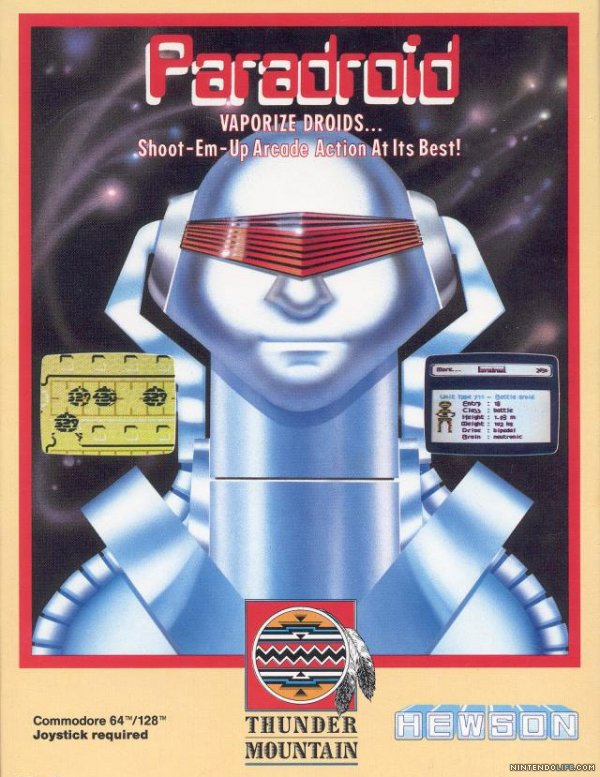
SSJKamui gives you retro gamers something to consider from our forums. In 2006, indie developers Ovine by Design remade this classic for modern Windows systems. The screencaps you’ll see will be from the Ovine remake.
Overview: Paradroid is a videogame for the C64 computer, created by the English programmer Andrew Braybrook, where the players play a robot who has to fight other robots who have overtaken a spaceship. If the player wants to, he is also able to hack the robots to control them.
Story: The robots of an unknown spaceship (the Paradroid) rebelled against their masters and took the ship into their control, but one small Robot fights them.
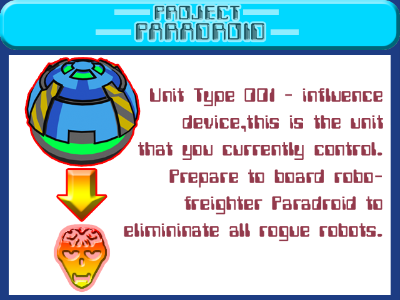
Like all older computergames, the story is extremely thin and only contains a few cyberpunk elements. The elements present in the story are a focus on the underground (the game centers around the robot servants of humanity and the player is playing one of the weakest robots. This can be seen as the “Underground of the Underground”.). The Information Access theme is present through the hacking parts.
The negative impact of technology is also present, because the robots attacked the humans on the ship and possibly even killed them. Because, in the game, there are no humans, there is obviously no “Fusion of Man and Machine” element.
The Visuals: The Visuals of the game are abstract labyrinths, mixing metallic looking borders with a cyberspace like environment. (Because of this, the Visuals are very cyberpunk.)
The robots on the grid are represented as abstract circles with a registry number in the middle. During the hacking, you see the actual physical shape of the robots. The hacking interface is a circuit diagram like representation of the ports of the robot. (This is also very cyberpunk like.)
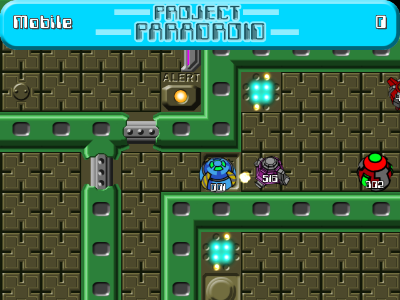
The abstract visuals are among the coolest aspects of the game, although they are extremely simple.
Gameplay: The player moves his robot through the ship and is able to attack hostile robots with his lasers or he can dock and try to hack them. The hacking is a more hardware hacking, where the player has to gain control over the ports of the enemy robot. (In fact, this is extremely complicated and requires a high amount of dexterity. Because of this, I never succeeded in it.) When the player fails, he is destroyed. Else, he controls the enemy robot and can use him in turn to hack other robots. The higher the registry number of the robot, the more complicated is hacking him. In some aspects, the game is a kind of “Hacking arcade game”. The gameplay is fun, but personally, I think it’s a little bit too hard.
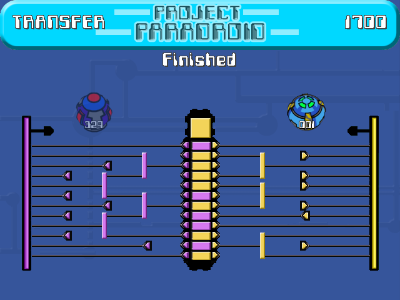
If you’re familiar with hacking in Nercron, this should look familiar.
In the game, nearly nothing about the game mechanics is explained, so, a look in the manual is often needed.
Conclusion: Paradroid is a very interesting game, but not a very good game for long term play. It’s more a game for short sessions. The graphic is simple, but indeed interesting. Because of it’s high difficulty, I can’t recommend it for people who don’t play very often. For hardcore gamers, it can be indeed a very entertaining game.
Postscript from Mr. Roboto: If you want to play Paradroid, but don’t have your C64 anymore, head over to Ovine by Design and download their remake, Project: Paradroid. It’s Paradroid with updated graphics. See if it brings back any fond memories of your Commodore days.
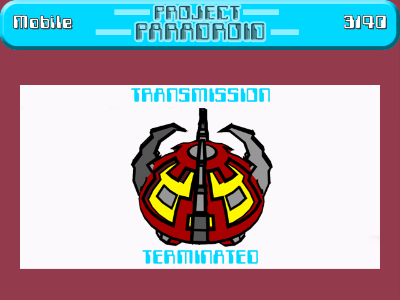
This post has been filed under From our Reviewer Forums, Cyberpunk Games by Mr. Roboto.
Review By: Gren
Year: 2008
Developer: EA Digital Illusions CE
Publisher: Electronic Arts
Platforms: Xbox 360, PS3, PC
Degree of Cyberpunk Visuals: High
Correlation to Cyberpunk Themes: Medium
Rating: 7 out of 10
Finally managed to pry my head out of my ass. I don’t like letting CPR go so long without some kind of review or news, so I’m going to act on a suggestion from our resident Stormtrooper of Death. If I see that there have been no front-page updates and I haven’t read/watched/played something worth reviewing, I will check the reviewer’s forum and post a review from there. This way, should the news be slow, we can keep this site fresh.
To start, here’s Gren’s take on the recent parkour/free-running game Mirror’s Edge (Link to the Reviewer’s Forum post). I purchased this game via Steam, but couldn’t play since my video isn’t up to specs. Once I do that upgrade and get to play, I’ll post my little review in the comments. Till then, take it away, Gren… Mirrors Edge was one of those games I was psyched about for months. I hung on every second of the hauntingly beautiful trailers, did my best to chisel out every little detail I could about the games stirring theme: A lone girl named Faith (who happens to be a Parkour expert) attempting to live free in a society ruled by a psychotic surveillance state.

You just gotta have Faith.
The product they ultimately delivered possessed all of these qualities in theory, but the theme was more or less ignored in favor of a simplified plot involving a kidnapping by the government, a thinly veiled conspiracy, and a daring rescue. It was about when I was sneaking into the office of a pro wrestler turned ‘goon in a suit’ named “Rope Burn” to interrogate him that I realized the game was getting a little bit off message. Also, the game sometimes seems like it’s trying to convey some sort of political message, but apparently it keeps getting confused on which message it’s trying to send. On one hand, the cuddly nanny state which takes the place of the games thematic antagonist is typically a perversion of an overly liberal society (”you don’t need guns, we’ll keep you perfectly safe, there’s cameras everywhere, self defense is so last century”). Yet halfway through the game your apparent enemy becomes a cartoonishly evil Private Military Corporation (which is why it scores “Medium” on the theme rating instead of “Low”), which is a theoretical scenario associated with an overly de-regulated or libertarian society. It’s also entirely possible that this mash up is entirely apolitical, but the theme seems to be at odds with itself in this regard.
There’s a lot of cyberpunk fluff padding out the games plot, such as hideouts bristling with computers constantly monitoring the city’s surveillance grids and police patrols, the members of the protagonist’s organization all have these cool circuitry tattoos denoting some sort of ‘hacker status’, but it rarely has anything at all to do with the game itself. Also, because the cutscenes are delivered in a trashy 2d flash animation style, it removes these elements even further from the experience.
However, the visuals of the game itself warrant a mention. When you’re standing on the edge of a sky scraper, over looking an endless white city sprouting from the earth like fragments of polished bone, speckled with only sporadic blotches of color (usually propaganda billboards), watching cars drift silently up and down the thoroughfares like drone insects, you’ll feel for a moment that the whole is greater than the sum of its parts.

Nosebleed territory…
You can find plenty of reviews that will explain the particulars of gameplay and story in gratuitous detail, but for the purpose of this site, suffice to say the gameplay is fair and with an emphasis on movement rather than combat (though combat certainly exists and is seldom optional).
In closing, Mirrors Edge is still an enjoyable game, even with the afformentioned detractors from the plot and theme. It’s extremely linear and has no significant multiplayer to speak of, so replay is limited. It’s definitely not a game for everyone, and some folks will tire of it exponentially faster than others. If you can forgive it’s short comings, though, somewhere in the midst of a forty foot jump between buildings, with the streets below passing like a dizzy dream and the birds scattering in anticipation of your landing, you might find the feeling the game is trying to convey.
This post has been filed under Cyberpunk Games by Mr. Roboto.
Review By: Mr. Roboto
Version Reviewed: 2.2, aka “Beyond Dome of York”
Year: 2002, 2004
Developed by: Reakktor Media GmBH
Platforms: Windows
Official Site
Degree of Cyberpunk Visuals: Very High
Correlation to Cyberpunk Themes: Very High
Rating: 9 out of 10
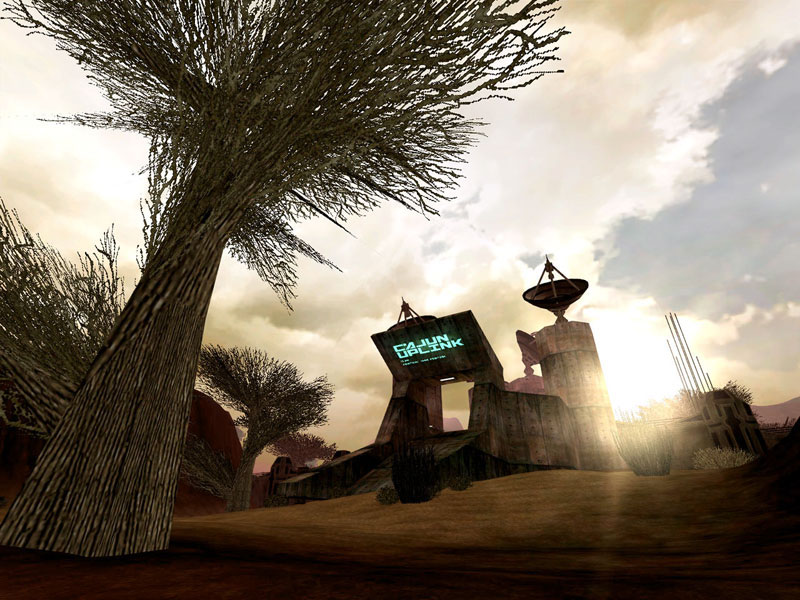
“By the end of the third millenium, Earth has changed…
Global pollution, excessive wars and a perforated atmosphere have turned the planet into an almost lifeless sphere of toxic mud. Radiation is everywhere and most animals have either gone extinct or have mutated into bizarre monstrous creatures.
The remnants of mankind seek protection from the desolate, scorched world and gathered behind the protective walls of giant cities. These few mega cities became the last lights of hope, in the darkness of Earth’s final dusk…” Overview: While World of Warcraft has captured the online world’s attention, cyberpunk fans have had their own MMOFPSRPG to explore. Neocron was initially released in 2002, with the current 2.2 originally planed as on add-on but has since become its own game. Featuring a dark, gritty cyberpunk future setting, Neocron is the very definition of the genre as you deal with robots, psychopaths, mega-corporations, drugs, guns, implants, naked chicks, mutants, …, and an intricate political backdrop among the factions in the future city.
The Story (so far): A nuclear war in 2143 wipes out most of humanity, and causes massive tectonic activity that decimates what was left. It would take some 300 years before humanity recovers to the most basic levels, with two cities rising from the ruins: Neocron and the Dome of York. It is now the 28th century, and the last two cities are now in decline; The Dome of York was nearly destroyed in a war with Neocron, while Neocron has had several coups, the most recent has ousted the ruling Psi Monks and installs Lioon Reza as ruler.
You enter the arena of Neocron from MC5, a sort of “proving grounds” where new citizens are tested to see if they are strong enough to become productive. If they survive, they become “runners” and get to be teleported to their apartment where Mr. Jones awaits to give them starter missions to show what their selected career can be like.
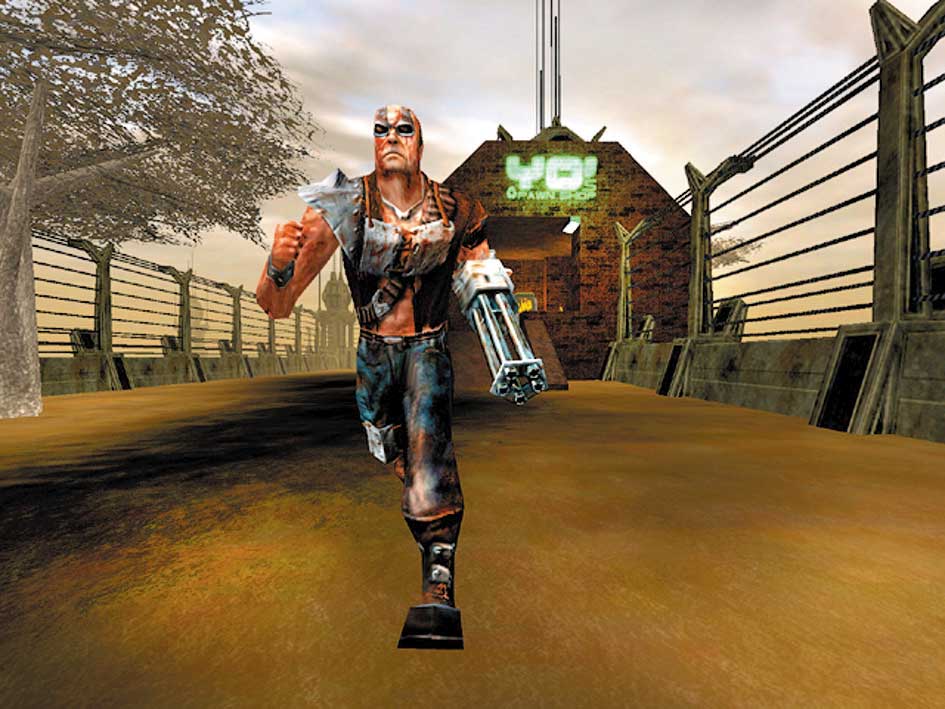
The welcoming committee
Career Paths. So many choices to make in Neocron, but some make better sense than others. First off, you need to select a “class,” the main type of person you want to be. The class selection not only determines what type of careers are available, but also how your character develops in the game. GenTanks (Genetically Engineered Human Tanks) are the muscles whose strong bodies and weak brains make them the main guns of Neocron. They can be soldiers, fighters, bodyguards, and even vehicle drivers. The Dexterous spies are not as strong as the Tanks, but they have abilities to be scientists, scouts, drone ops, assassins, and most importantly, HACKERS! The Psi Monks get to develop their psionic skills to become medics, inquisitors, and preachers. They can even use their intelligence to take up a spy-type job since their physical abilities don’t develop as fast. For the Private Eye, the world is their oyster. They can follow any career path they want, but since their skills don’t develop as well as the specialists, their abilities may not be the best.
The places you will go. Neocron is divided into several areas, with each area having one to four “sectors” in which you will explore and work in. The Plaza is the main area where several factions have headquarters and even recruiting offices. Plaza-1 is the main gathering place for players, especially in the Medicare building.
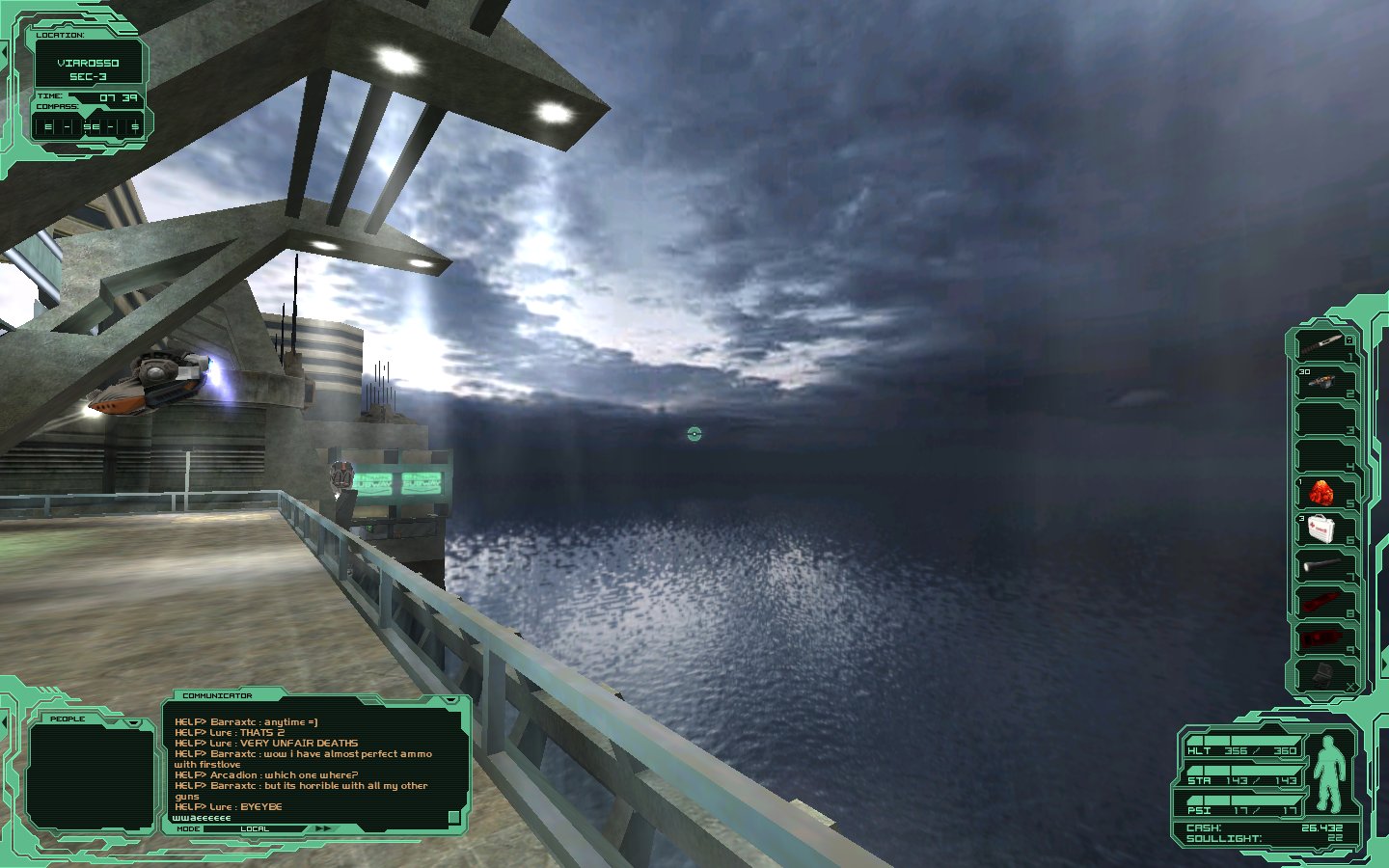
Via Rosso is the high-rent district of Neocron. Some of the corporate factions have headquarters here, including the Neocron City Police. This seaside view shows why the rent is high.
Neocron’s red-light district is Pepper Park. Here is where players can find plenty of “entertainment,” from the various clubs to NeoFrag, the deathmatch game-within-the-game. Also, several criminal factions have headquarters here.
On the outskirts, there are the Industrial Areas and Outzone. These areas are mostly abandoned and devoid of life, but beware of some crazies who will take pot-shots at you if they don’t like your faction.
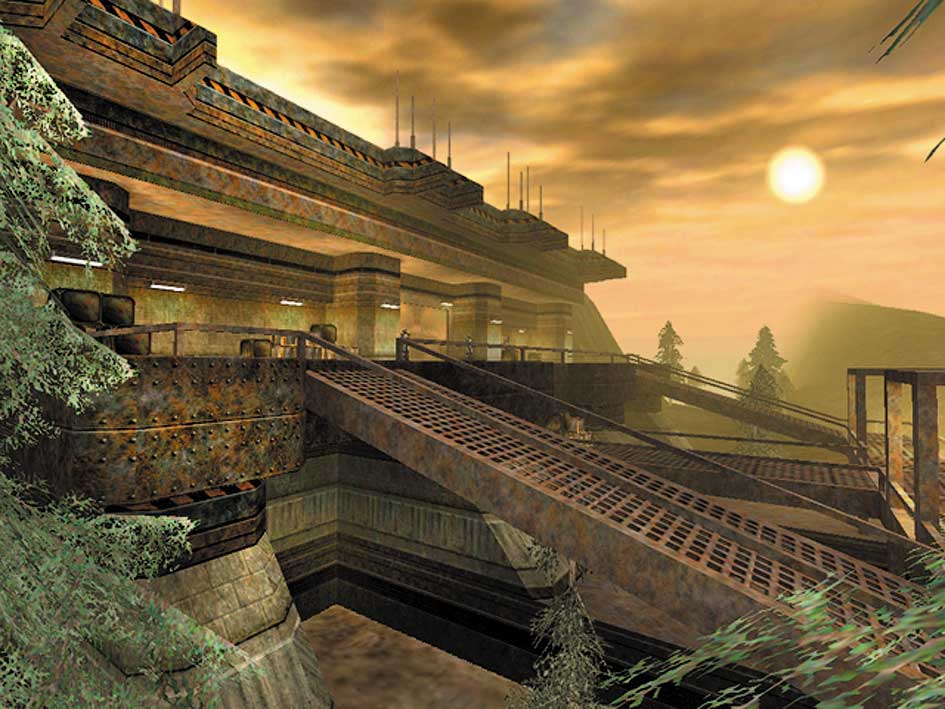
This is the main gate from Neocron, the exit to the wastelands beyond the city walls. There are outposts, mutants, and some anti-city factions out there, not to mention the Dome of York.
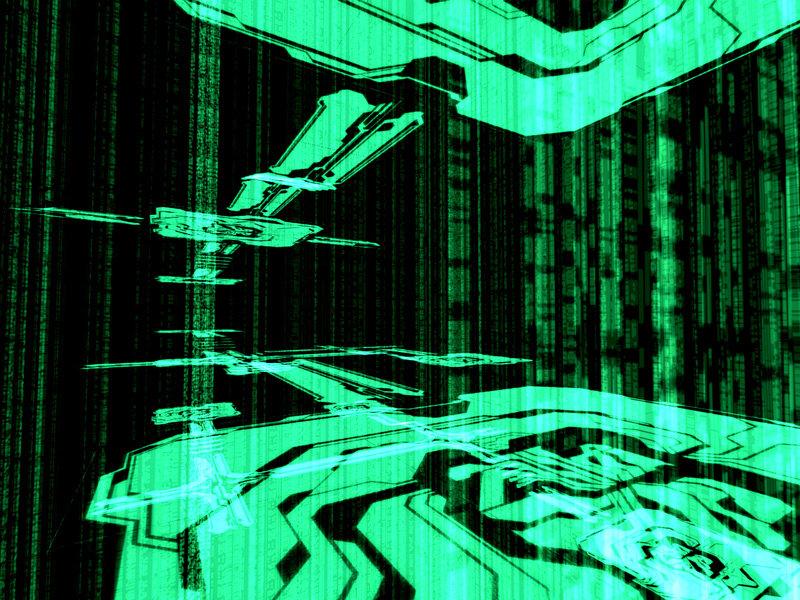
Hacknet - the playground of the 1337 hacker. One who is skilled enough can travel between different areas of Neocron… and beyond. The best ones can find valuable data other players can use.
Patience is a virtue. There is so much to learn about in Neocron that one needs to be patient to learn them. The main thing is learning how to distribute their skill points appropriately for their career. Players may also want to use some skill points for “tradeskills” such as implanting, construction, and recycling. I’ve seen so many requests for construction and implanting (”poking” in gamespeak) that I’m considering implanting as a main tradeskill, though I’ve already attributed some to recycling. If you want to prepare or educate yourself for Neocron, I’d suggest checking TechHaven and NeoTerm along with the official site. They have FAQs and guides to help you in your career, and forums where you can ask for advice.
Another reason for patience is due to some bugs in the game, and not just the ones in the sewers. Reports of items disappearing is the most common, though it hasn’t happened to myself. The main problem I’ve had, other than pulling myself away or encountering creatures I’m not strong enough to deal with, is “fatal program error.” Probably a connection problem I need to look into. Other than that, not many technical problems.
Conclusion: Neocron has that certain potential to be a Warcraft killer, though it is certainly a cult-favorite at best. Makes me wish I was hacking and poking around Neocron 1 when it came out. I’m glad to have had a chance to do my stuff with 2.2 and would like be there for 3.0. Even so, I do need to pull away to some more reviews here… must… log… out… of … Neo… cron…
This post has been filed under Cyberpunk Games by Mr. Roboto.
Review By: Mr. Roboto
Year: 1999
Developed by: Irrational Games and Looking Glass Studios
Published by: Electronic Arts
Platform: Windows
Degree of Cyberpunk Visuals: High
Correlation to Cyberpunk Themes: High
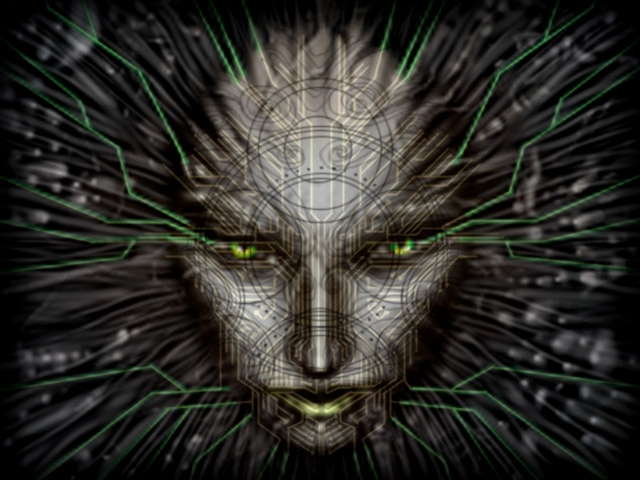
I never forget a face. Sometimes, I wish I could.
When the original System Shock was released 1994, most probably didn’t realize what new grounds would be broken in terms of first-person shooters. Five years later, history would repeat as a second Shock would not only improve upon the original, but totally raise the bar for games to come. Shock 2 raised the stakes with improved 3D graphics, new weapons and abilities, a cooperative multiplayer option, and a new story with enough twists to keep you playing until the end.
The post-Citadel story. TriOptimum tried their best to keep the events aboard the Citadel space station under wraps, but word eventually leaked out about Edward Diego, his hacker, and SHODAN. The outrage caused the formerly ineffectual governments to form the Unified National Nominate, the UNN. They fight TriOptimum using the most powerful weapon they have: bureaucracy. TriOptimum started fighting back with their corporate-military forces. Eventually, a truce was borne of a stalemate between TriOptimum and the UNN, but technological advances slow to a crawl as many blame the UNN for Earth’s slow death.
Then, a major breakthrough: A device that warps time and space around it enables faster-than-light travel. A joint TriOptimum/UNN deep-space venture is solidified as the corporate starship Von Braun will be traveling with the UNN Rickenbacker riding piggy-back, literally. The launch occurs in 2114, some 42 years after Citadel.
Five months into the mission, the tandem receives a signal from Tau Ceti V. An away team from the two vessels return from the planet’s surface with artifacts and what appears to be large egg-like cases.
That’s when things go fruit-loopy…
Three years before launch… You arrive at the UNN Recruitment Center with hopes of being onboard the Von Braun/Rickenbacker when they make history. Before that, however, you will have to go through some training to prepare for the possible dangers you will face. Newbies should take advantage of the Basic Training area to familiarize themselves with the game’s controls and interfaces. Then it’s off to Advanced Training where you can experience some of the fun things you’ll do with the three branches of the UNN military machine. From there, it’s off the shuttle bays where you will be taken to a station to begin a three-year training program of three one-year tours of duty where you can build up your stats in weapons, technical skills, physical attributes, and maybe some psionic skills.
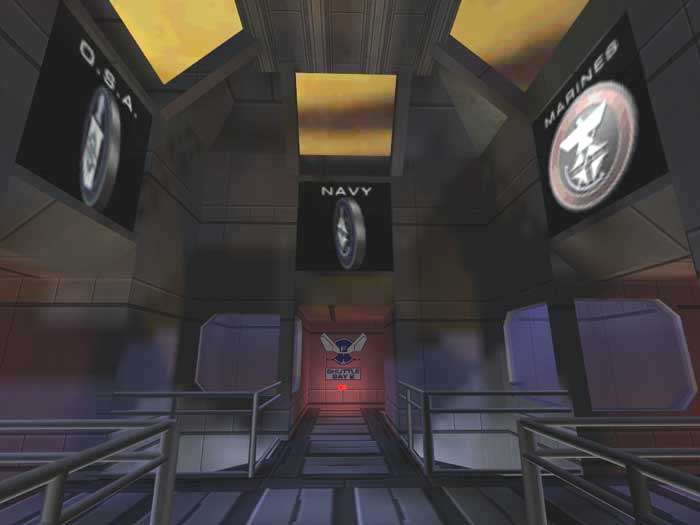
Here are the three military branches of the UNN:
Marine Corps. The few, the proud,… the trigger-happy. Marines shoot first and ask questions latter, and are happiest when they have a big gun in their hands, and it doesn’t matter if the gun shoots lead slugs, concentrated energy, or explosives for those festive occasions.
Navy. Dealing with the high-tech machinery to sail the seas of stars requires some high-tech abilities, and these future midshipmen are the researchers, maintenance crews, and hackers of space. They practically wear their geekiness… and their pocket protectors… on their sleeves.
OSA Taking their cues from MK-ULTRA, the Majestic Twelve, the NSA, and the Freemasons, the OSA takes “psychological warfare” to a new level as their ranks are highly trained in psionic abilities that would rival Professor Charles Xavier himself.
Your adventure aboard the Von Braun/Rickenbacker tandem actually begins in a cryo-tube with some military-grade implants and memories lost due to a computer glitch. Dr. Janice Polito contacts you, wanting you to meet her in her office on deck four to discuss what has happened to the two ships and how to correct the problem. Getting there won’t be easy.
Cyberspace gives way to connect the dots. One important change in Shock 2 is the lack of cyberspace sequences, although there are the VR booths in the training center. Instead, an odd game of ‘connect the dots’ is used for hacking, repair, and weapon modification. If you choose to ‘play,’ you need to light three dots or ‘nodes’ in a straight line to succeed. There may be a node outlined in red (ICE nodes) that require extra caution, as causing these to go dark will cause an immediate failure. What that failure entails depends on the device.
Research… and destroy. Another change is that some items require research. Some items only give information on how to best kill enemies. Others require research before they can be used. There are chemical storerooms where you can find the chemicals you may need to complete your research.
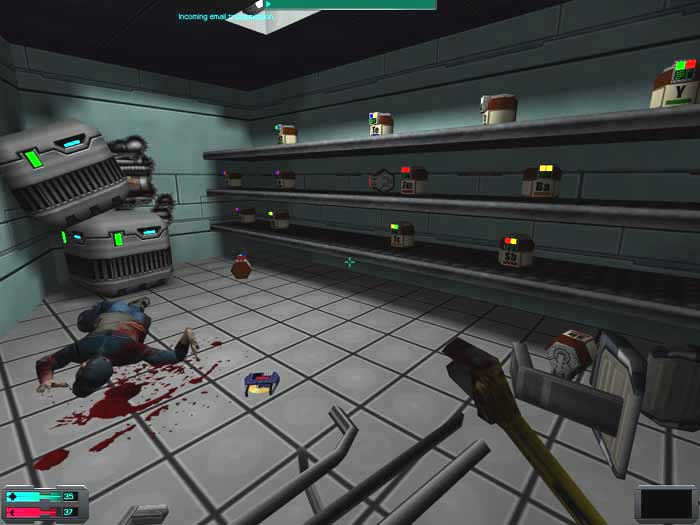
A worthy successor. Like Quake was to Doom, Shock 2 is a worthy successor to the original Shock. A trip through the corridors of the Von Braun/Rickenbacker tandem will show you how it improves on the original.
And if you’re up for it, you can check the next page to see how this classic shocker can creep-n-gross you out…
Page 2: More Screencaps –>>
This post has been filed under Cyberpunk Games by Mr. Roboto.
Review By: Mr. Roboto
Year: 1994
Developed by: Trip Media
Produced by: Phillips Media, Inc.
Platforms: CD-i, DOS\Windows, Macintosh
Key Cast Members:
Sol Cutter: Aaron Schwartz
Kris: Viva Duce
Gala: Abigail Canton
Female Cutter: Tanya Pohlkotte
Golden Buddha: Indra Sinha
Bonus CD Track Listing:
1. Burn:Cycle (Theme)
2. Karmic Church
3. Flying
4. System Software
5. Buddha’s Voice
6. Into The Televerse
7. Psychic Roulette
8. Zip
9. Kris VR
10. A Beautiful Relationship
11. Meltdown
Degree of Cyberpunk Visuals: Very High
Correlation to Cyberpunk Themes: Very High

Data thief Sol Cutter has something on his mind. In two hours, it will reformat his cortex into pudding.
Overview: Originally released by Phillips for their CD-i CD interactive system, Burn:Cycle is a live-action interactive movie, a mash-up of Blade Runner and Johnny Menmonic, with some mini-games and puzzles thrown in. The movie/game follows Sol Cutter as he tries to remove a computer virus from his implant while the player controls some of his actions.
If you’re lucky enough to find a version with a bonus CD, you’ll have the extra treat of listening to the music of Simon Boswell, who not only does the soundtrack for Burn:Cycle but also Hardware and Hackers.
The Story: Sol Cutter is a small time data thief who gets his big chance. All he has to do is infiltrate Softech, download some files, sneak out, and get paid for his efforts. Piece of cake…
… except someone put arsenic-flavored icing on that cake. A sudden surge of data hits Sol upside his head like a brick, and left a nasty little going away present. A virus called Burn:Cycle is now in his neural implant. It’s dormant for now, but if Sol doesn’t get that virus out before the clock hits zero, he’ll get a headache no amount of aspirin or ibuprofen will ever cure. That’s assuming Sol manages to get out of Softech in one piece…
The countdown to Sol’s destruction begins from the word go, and all you have to save him is your mouse… and some stuff in your inventory, plus whatever stuff you can find along the way. The mouse cursor will change whenever a certain action is possible, and clicking will make Sol perform that action from moving around to shooting to using objects. Point-and-click action is also used in the mini-games you’ll play along the way.

Sometimes, a man just wants to get in touch with his feminine side.
Televerse, not cyberspace: Sooner or later, you’ll be jacked into the Televerse to find something to get the Burn:Cycle virus out. It operates much like real time in the game, except there’s a central location called The Pulse that you can instantly jump to since some locations in the Televerse don’t have exits.

“It ain’t easy bein’ a two-bit thug in an eight-bit town.” (Sol Cutter)
Bad Graphics, Good Music: PC users may be in for a bit of a system shock when they first play Burn:Cycle, especially if they’re used the accelerated graphic capabilities of their nVidia or ATI Radeon cards. Burn:Cycle was originally ported to the PC during the twilight of DOS/Windows 3.1x. Had Phillips waited, they could have taken advantage of Windows 95’s Direct X drivers, giving them better graphics.
While the graphics leaves much to improve on, the music from the bonus CD gives those who can’t play the game on their NT-based systems an opportunity to experience the game’s environment from the audio side. The music, composed mostly by Simon Boswell, comes straight from the game and even features some dialog for good measure. My favorite track is number 10, “A Beautiful Relationship,” sounding like an electronic version of the saxophone-background music of private-eye fare while a woman who sounds like a prostitute speaks her mind (“Normally I’d like to keep my knees below my ears on a first date.”).
Conclusion: Burn:Cycle is a classic game that has earned its place along side the likes of Syndicate and Blade Runner for good reason. It would have easily been a ten-star game had the graphics been up to snuff. Still, having Burn:Cycle in your collection (as opposed to your neural implant) is a big win. And having the music CD with the game is a major find.
This post has been filed under Cyberpunk Music, Cyberpunk Games by Mr. Roboto.
Review By: Mr. Roboto
Year: 2000
Developed & Published by: Nexus Interactive Studios
Platforms: Windows
Official Site: AI Wars
Degree of Cyberpunk Visuals: Very High
Correlation to Cyberpunk Themes: Very High

Overview: Billing itself as an “action/strategy hybrid,” A.I. Wars is essentially a first-person shooter with a cyberpunk twist. All the action takes place inside computer systems with your avatar and the software installed. Unlike other FPSs like Quake, each system can be visited in any order you wish, and re-visited as often as needed. And re-visit systems you will need to do if you want to find key software upgrades and technological breakthroughs needed to accomplish your selected missions, since the data in those systems is always changing. While you’re “visiting” these systems, there’s other avatars to interact with, markets to trade goods and data, and ICE and viruses to battle. As long as your avatar maintains its integrity all is good. However, if your avatar dies online, your brain is toast.
Welcome to the NET of the future…
The Story: (From the official site) In the 21st century the NET is the new worldwide computer network. It regroups everything from antique copper wire networks to high speed gigabit satellite networks. Every corporation in the world, every military organization, every university, every library, and even every home is now wired-in 24 hours a day. This almost infinite information world is inhabited by hordes of agents in the service of humanity. These agents are expert applications that collect and filter information as well as conduct electronic transactions for their masters. It is rumored that certain high-level agents have escaped from military sites in the early phases of the NET and were never recovered. Beware! These agents may still be around and are evolving. They may even become sentient soon and claim the NET as their own.
Since the advent of ultra fast Virtual Reality engines in the late 20th century, the incredible advances in processors and memory, and the invention of the first direct neural connection system at MIT in the late 2050’s cybernauts have been able to directly project into the NET and control their agents through this more direct interface. Their representations in that electronic world are called avatars. Jason Skinner said it best when he exclaimed after his first try “Damn, it’s like being there!” The advent of those technologies has created serious social, psychological and medical problems. An intense addiction to the NET has been cited more than once has the cause of divorces, bankruptcies, etc. From a medical standpoint, in the beginning it seemed that whenever an avatar was destroyed, the cyberstations would overload the person’s brain with a high-energy electrical burst thus killing them. Cyberstations were quickly modified to safeguard against this. However, it is said that the interaction with the NET is less direct because of these modifications. “A lot of cyberhackers have disabled these safeguards and are at risk,” said Bruno Gaza from Turing, the NET police. “It’s like the Wild West, but a whole lot more dangerous!”
Your Mission(s): One unique feature of A.I. Wars is that you can choose from three missions to complete when you start a game, and you can choose any one, two, or even all three. They are:
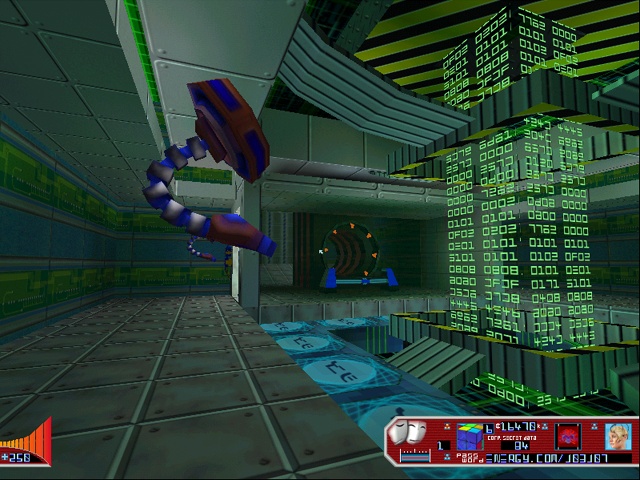
Control (Pwn) the NET: Each system you visit will have a core that controls it. To hijack a system, you need to touch the core (the circular thing you see in the background of the above shot), placing a “backdoor” that will make the ICE think you’re the sysadmin. Hijack all the systems to pwn.
Become Immortal: Somewhere in all that data lies important breakthroughs needed to develop key technologies that will allow you to upload your consciousness and memories to the NET and become immortal.
Make Your Avatar Sentient: This requires not only developing technologies, but gathering enough data so your avatar can learn and grow.
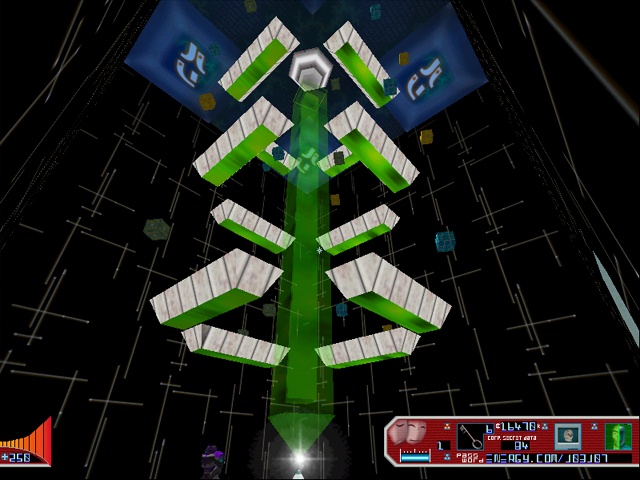
MMMMMmmmmm… datablocks!
There are six different endings for the game (other than your death) possible with these missions. What ending you’ll see depends on what missions you choose and how well you perform them.
Skating on thin ICE: Even on the NET of the future, there has to be some law and order. That is provided by the various ICE you will encounter. Wardens act as gatekeepers or doormen, only allowing those with “authorized access” to pass, but you can use your crack software to get that access… just don’t look for sympathy from the other ICE if you brute-force your way past a warden. There are Exterminator ICE who patrol public areas, while Black ICE keep private areas secure and come to the aid of wardens. Turret ICE hang above doorways and portals to stop intruders like you, and if that isn’t enough protection, you may find Hunter/Killers near a core. The H/Ks tend to attack in pairs, one doing a frontal assault while his buddy teleports behind you for a sneaky double team. Nasty.
As if the ICE wasn’t bad enough, some systems have Black Widow and/or Tarantula viruses, left by other hackers to give you grief. Better have a good firewall and anti-virus software if you go into an infected system. Unlike the ICE who wait until you shoot first before retaliating, viruses will attack on sight.
Not all the agents you encounter are hostile. Most of the human-like avatars will go about their own business and leave you alone, unless you start a fight with one then it will defend itself.
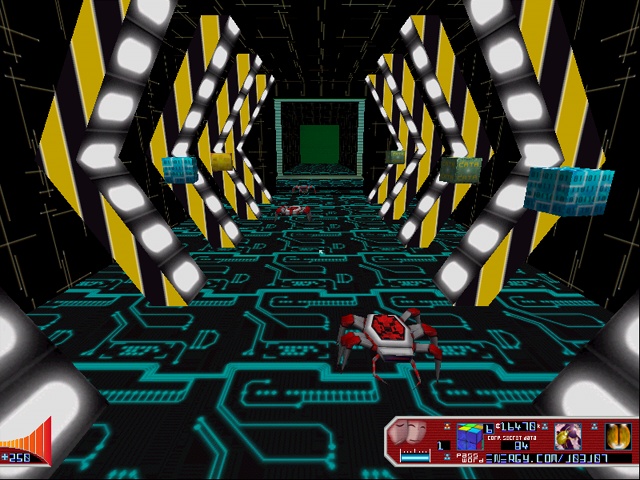
You will also encounter retrievers, spider-like netcrawlers (webcrawlers?) that carry datablocks between data stores. In some systems, these retrievers may hold some valuable datablocks like software upgrades or breakthroughs.
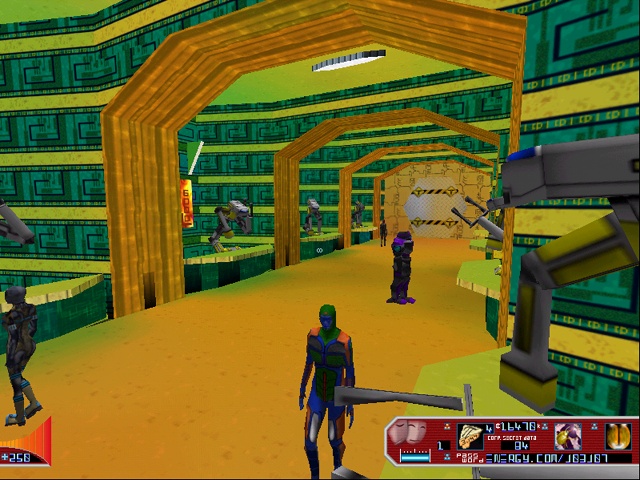
Need a new firewall or updated ICEbreaker software? Want to sell your corporate secrets and obsolete tech? Come to Mr. Roboto’s Virtual Market, where our crew of market bots are ready to make deals! Offer good while supplies last. Not sold in any brick-and-mortar stores.
Bugs In The System? Maybe they’re “features?” Any type of program is bound to have some technical glitches, and A.I. Wars is no different. Of course, since the action takes place inside a computerized environment, some may seem par for the course. Like when you use your last masquerade, only to be left with some 65,000 left. Or when you shoot an ICE and hear its death scream, only to have it continue to attack you while you keep plugging it with your ICEbreaker attacks (I find in this case zapping it with the IRC will shutdown the stubborn ICE).
Conclusion: While it didn’t make the big splash-damage of Doom/Quake proportions, A.I. Wars does make a refreshing change-of-pace from the usual kill-em-all-and-let-god-sort-the-carnage first-person blast-a-thons. While learning the nuances in the NET is a bit tougher than other games, the results in owned systems, sentient agents, and an immortal soul is well worth the effort.
See you on the NET…
This post has been filed under Cyberpunk Games by Mr. Roboto.
|














































